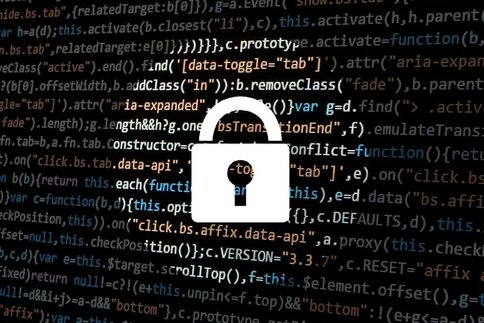Nothing works anymore: It's time for more cyber security in logistics chains
Logistics works in a network. The more interfaces there are, the more vulnerable the supply chain is. Digital attacks are a major threat. Find out more about the challenges cyber security poses for transport and logistics.
Cybersecurity is protection against digital attacks. Knowledge of technologies, processes and guidelines should prevent or at least mitigate attacks from the network. In our increasingly digitalized world, this is a task that goes beyond the boundaries of the IT department and is becoming a top priority. Especially in the networked world of logistics.

Cyber risks permeate logistics chains
A lot can happen on the way from the sender to the recipient now that logistics is increasingly paperless. Trojans infiltrate malware, spyware monitors internet activities unnoticed, and ransomware encrypts business-critical data at lightning speed. More and more cyber criminals are attacking systems, paralyzing processes and taking advantage of people's cluelessness—a vulnerability in companies that should not be underestimated. Awareness of these cyber risks is more important than ever—especially in logistics, where many companies work with numerous partners and suppliers.

Logistics companies still far too carefree
In October 2023, the German Logistics Association (BVL) warned in its first major study on cybersecurity in supply chains, conducted jointly with the IT company secida: supply chains in Germany are not sufficiently secured - management is not sufficiently aware of its role in cybersecurity. Almost every second company has been affected by attacks within five years. In a press release, the cooperation partners state that the cross-company protection of supply chains against cyber attacks is still a marginal issue. Only 42 percent of companies considered the entire supply chain at this time.
Logistics chains are alarmingly unprotected
Despite the rapidly increasing threat situation, too many companies are still unaware of the risks. They are not only responsible for themselves, but also for the entire logistics chain. According to the BVL, small and large companies in particular lack an overview at the time of the study. This is why the topic will be back on stage at transport logistic 2025. And not just at BVL, which is presenting the current status and framework conditions in a new white paper. You and many other key players are facing more and more risks.
Cyber attacks are part of everyday crime
The fact is that transportation by road, rail, air and water is vulnerable. The internal flow of materials is just as vulnerable. Data controls logistics everywhere. Autonomous industrial trucks, automated processes with robots, state-of-the-art on-board technology in trucks are just as vulnerable as critical infrastructure, including terminals in railroad stations, seaports and inland ports, as well as airports. If one cog stops turning, the entire process grinds to a halt. Thieves use AI tools to gain access and send malicious links for phishing. They alter documents, manipulate IoT devices, especially on trailers, and steal not only data but also the entire freight, directly from the truck. The more autonomous the means of transportation, the more vulnerable they are. This is forcing not only infrastructure operators, logistics service providers and software providers, but also freight transport equipment suppliers to increase cyber security and transparency.
Every interface a gateway for cyber criminals
In collaborative work along the supply chain, systems, networks and programs connect everyone involved. They keep the flow of information moving, which is captured by end devices, processed by servers, stored and forwarded. Data is exchanged via countless interfaces, often live and in real time: without the latest information and communication technologies, from mobile devices to the cloud, almost nothing works in logistics today. Information at the click of a mouse, processed fully automatically, immediately and completely available—this has long been a matter of course for many participants. Even for cyber criminals. Every interface is a gateway. Every system is a data Eldorado.

Cybersecurity means continuous improvement
The threat situation is complex and is becoming increasingly opaque. Not all companies are capable of acting in an emergency. Many are haphazard and—even worse—lack full risk awareness for phishing, data leaks and attacks from the web. They need to identify vulnerabilities, eliminate misconfigurations, check updates, train employees—in short, be aware of all potential attacks. Security gaps must be closed so that business secrets, assets and infrastructures of all parties involved remain protected. New laws provide guidance. The Cyber Resilience Act has been in force since November 2024. The Act stipulates a legal minimum level of cyber security for networkable products that will be launched on the EU market from 2027. Products that are also frequently used in logistics. Further regulations are on the way, including the KRITIS Umbrella Act, which aims to better protect critical infrastructures, including in the transport sector, with IT security and notifications.
Swarm knowledge inhibits cyber risk
Between cost pressure, a shortage of skilled workers, customer requirements and new technologies, there is often little time left in the day-to-day work of logistics companies. Operational tasks take precedence over strategic concepts. In the case of IT security, until everything stops and nothing works. Because cyber attacks can affect anyone. Only those who act in good time are safe. Those who disclose attacks help themselves and others. Experience makes risks manageable. Many of these are incorporated into certifications such as ISO/IEC 27001 or NIST Cybersecurity Framework IEC 62443. The constant exchange of information about new attacks is important. The world's leading trade fair transport logistic can be a platform for exchanging information. It brings together everyone along the supply chain who organizes the flow of goods and information. Service providers, equipment suppliers, infrastructure providers and experts all come to Munich. As trade fair visitors, exhibitors and experts, they discuss current developments, security concepts and the latest standards for cyber security in the top-class supporting program with the aim of creating a zero-trust architecture to protect against threats.
